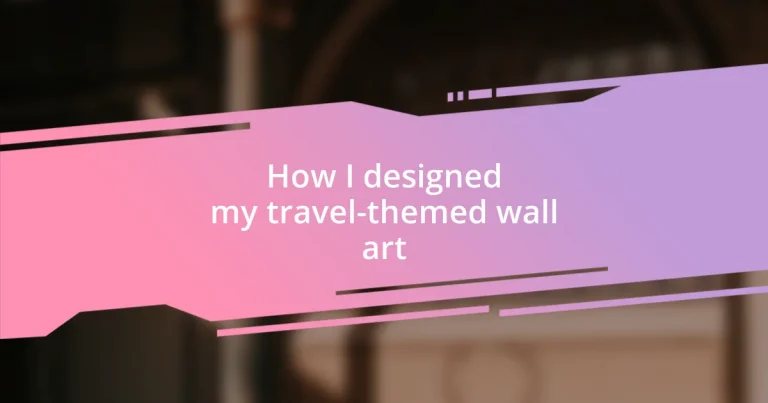Key takeaways:
- Choosing a travel theme for wall art should reflect personal experiences and evoke emotions linked to memorable places.
- Finding inspiration can come from various sources, including travel books, social media, and nature, each adding unique depth to the design process.
- Incorporating personal touches such as souvenirs, color choices, and handwritten notes enhances the intimacy and uniqueness of wall art, making it a reflection of one’s journey.

Choosing a travel theme
When I was considering my travel theme, I reflected on the places that had truly captured my heart. Travel isn’t just about destinations; it’s about the experiences that linger in our minds. Have you ever felt a specific moment in time – like the sound of waves crashing in Bali or the vibrant streets of Paris – that made you want to recreate that feeling in your space?
I finally chose a vintage map theme after finding an old globe in my attic. It sparked a nostalgia for my childhood dreams of exploring the world. The muted tones of the maps and the charm of aged parchment instantly transported me back to my adventurous spirit. Isn’t it amazing how a piece of wall art can evoke so many memories and emotions?
As you decide on your theme, think about what resonates most with you. Do you prefer the sandy beaches or the bustling city life? Each choice reflects a part of your journey, so consider what stories you want your wall to tell. For me, combining different elements—a world map and photos from my travels—creates a tapestry of my adventures that feels authentic and inspiring.

Finding inspiration for designs
Finding inspiration for designs can be a delightful journey in itself. I often find that a simple stroll through my local bookstore brings forth a plethora of ideas. Browsing through travel literature, I’m captivated by the stunning imagery and compelling narratives that spark my creative vision. Have you ever paused to admire a beautiful travel book cover and felt the urge to recreate that sense of wanderlust in your own space?
In addition to books, I turn to social media platforms like Instagram and Pinterest. Scrolling through tailored hashtags reveals fascinating art pieces and design concepts from fellow travelers. One time, I stumbled across a striking series of travel posters that showcased iconic landmarks in a minimalist style. I felt an instant connection, prompting me to explore how I could integrate those aesthetics into my wall art. Sometimes, it’s the staggering creativity of others that ignites your own!
Moreover, nature can serve as a boundless source of inspiration. I vividly recall a moment on a beach, where the colors of the sunset blended into a magnificent palette. The serene blues and fiery oranges got me thinking about how I could incorporate those hues into my artwork. Reflecting on real-life experiences often leads to the most meaningful designs, turning your wall into a canvas that resonates with passion and memories.
| Source of Inspiration | Personal Connection |
|---|---|
| Travel Books | Imagery and narratives ignite creativity |
| Social Media | Discover trends and fellow artists |
| Nature | Real-life experiences bring depth |

Selecting materials for wall art
Selecting the right materials for wall art is crucial in bringing your vision to life. When I crafted my travel-themed pieces, I found that the texture of the materials adds an extra layer of depth to the artwork. For instance, I enjoyed using canvas for its durable finish and ability to absorb paint beautifully, which allowed me to replicate the vibrant colors I often saw in my travels. I also experimented with wood to create a rustic, warm feel that reminded me of old travel lodges I once stayed in.
Here are some materials to consider when designing your wall art:
– Canvas: Great for painting or printing; offers a textured look.
– Wood: Provides a natural aesthetic; perfect for rustic themes.
– Acrylic sheets: Creates a modern effect with a glossy finish; ideal for contemporary designs.
– Fabric: Softens spaces and adds an inviting texture; can be used in quotes or maps.
– Paper prints: Highly versatile; easy to frame and hang, making it budget-friendly.
Each material evokes different feelings and memories. For example, I remember using an old piece of reclaimed wood from a family barn—it connected me to my roots and also gave my artwork a unique story. Opting for materials that not only fit your theme but also resonate with your personal experiences can make all the difference in your design journey.

Techniques for creating art pieces
Creating art pieces requires a mix of techniques that allow your personal style and inspiration to shine through. One approach I found particularly rewarding is collage-making. I love combining various materials—old maps, photographs, and even ticket stubs—to represent different travel experiences. Each piece I create feels like a mini-time capsule of my adventures, inviting viewers to share in those memories. Have you ever made a collage that tells your story?
Another technique that excites me is layering. When I designed a piece that showcased my favorite travel destinations, I started with a painted background that reflected the atmosphere of the locales. Then, I added translucent layers of paper featuring silhouettes of landmarks. This layering not only creates visual interest but also invokes a sense of depth—much like the complexity of travel itself. It’s amazing how a bit of transparency can symbolize the hidden layers of experiences that shape our journeys.
Don’t underestimate the power of mixed media either. In one of my favorite projects, I combined illustration, typography, and photography to capture the essence of a beautiful city I visited. I still remember how elated I felt when my friends praised it, saying it encapsulated the spirit of the place perfectly. Mixing different artistic styles can generate unexpected results, transforming your wall art into a vibrant narrative that’s uniquely yours. What do you think? Isn’t it fascinating how each technique can provoke such personal reflection?

Arranging the artwork effectively
When arranging your artwork, the placement is crucial to creating a cohesive display that draws the eye. I remember experimenting with various layouts, from a linear arrangement to a more eclectic gallery wall. I found that grouping pieces by theme or color can evoke specific emotions, almost like telling a story right on your wall. Have you ever noticed how certain combinations immediately spark a connection?
To create balance, I learned to consider the size and proportion of each piece. For instance, I placed my largest canvas depicting a breathtaking sunset as a focal point, surrounded by smaller artworks. This approach not only highlights the centerpiece but also creates an inviting flow that encourages exploration. It’s fascinating how the eye naturally gravitates toward the largest pieces first, right?
Don’t shy away from experimenting with heights and angles, either. I once hung a few pieces asymmetrically on one side of my wall, allowing for a playful touch in the overall arrangement. My friends often comment on how this quirky display keeps their attention and inspires curiosity about my travels. The beauty of wall art is that it can evolve with you—so be bold and trust your instincts as you create your unique space.

Adding personal touches to designs
When it comes to adding personal touches to my designs, I find that incorporating souvenirs is incredibly rewarding. For instance, I once used a small, broken compass my grandfather gave me. I framed it alongside a vibrant watercolor painting of a sleepy coastal town we loved visiting together. That piece now carries a sentimental value, reminding me not just of the trip but of the stories and lessons that came with it. Have you ever included a meaningful item in your art?
I also enjoy reflecting my emotions and experiences through color choices. In one piece depicting a bustling market in Marrakech, I used fiery reds and warm golds to capture the vibrant energy I felt while wandering those streets. Each brushstroke was a memory—a reminder of the laughter, the aromas, and the excitement in the air. Isn’t it fascinating how colors can evoke such deep connections?
Finally, I’ve found that integrating handwritten notes or quotes in my artwork adds a layer of intimacy. While creating a canvas inspired by my solo trip through Italy, I included snippets of my journal entries in the background. Every time I glance at it, I’m taken back to those moments of discovery and self-reflection. It’s like having my thoughts visually intertwined with the art, making it truly unique. Do you have a favorite quote or thought that you feel compelled to include in your own creations?

Maintaining and updating your art
Maintaining art is just as important as creating it. I’ve discovered that dusting my pieces regularly keeps them looking vibrant and inviting. I often take a soft cloth to gently wipe away any buildup, allowing the colors to shine and the memories to pop, almost like giving my artwork a refreshing breath of life. Have you ever noticed how something so simple can make such a big difference?
Updating my travel-themed wall art is something I relish. I enjoy occasionally swapping out pieces to reflect new adventures, as each trip brings fresh stories to my walls. This past summer, I replaced a coastal painting with a more recent watercolor of the mountains I hiked in Colorado. Every time I walk past that wall, I’m reminded of the crisp air and stunning views, making it feel like my home is a living scrapbook. Have you ever thought about how changing just one piece can completely alter the vibe of a space?
The emotional connection to my wall art deepens when I rotate or add new pieces. I find it invigorating to tell a new story through my collection. For example, I recently turned a small nook into a gallery space where I display photos and mementos from my travels. It feels almost like inviting friends to step into my adventures, doesn’t it? By keeping things dynamic, I not only maintain my art but also ensure my space reflects who I am in this moment of my life.














